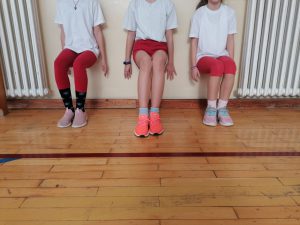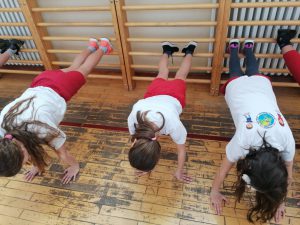Physical activities
Do you do any physical exercises?
Are you one of those who are physically active all day or do you prefer to sit, draw, watch TV or surf the Internet? If you have no health problems and the doctor has not forbidden you to engage in physical activity, it is important to find some physical activities that you enjoy in.
And why is it important? If you are not physically active at all, you rarely walk or run fast, you don’t ride a bicycle, rollerblades, you don’t play with your friends, your body will get weaker and weaker and you can get seriously ill (heart disease, obesity, diabetes are just some of the diseases that often arise due to a long-term lack of physical activity). If you have enough physical activity during the day, you will have good health and you will feel better, more agile and stronger, and your brain will work much better.
What does it mean to have enough physical activity? Firstly, it would be good to exercise for at least 1 hour a day, so that during an exercise you start breathing rapidly (fast walking, running, riding a bicycle, rollerblading, skating, skipping a rope, playing basketball, volleyball, football…). Secondly, 3 times a week you should do exercises in which you feel that the muscles of your arms, legs and trunk are straining, becoming hard (squats, plank, pull-ups, push-ups, climbing a tree…). Thirdly, start learning at least one skill that is interesting to you, but you haven’t learned it yet (jumping a rope, rollerblading, skating, dancing, bouncing a ball or something else). If you are already active enough and you are doing this – you are already a real exercising champion!
Are you physically active enough and what are your physical abilities?
You can track how much physical active you are by using fitness bracelet or watch, and various fitness applications on your phone. You should know that you need to have at least 60 minutes of physical activity which will make you breath faster like during running. If you want to track your steps, you should make 10.000 steps a day.
If you want to find out if your physical abilities are excellent, good or not so great, you can test yourself by watching instructions of the FITBACK monitoring system on this link. If you want to compare your strength and aerobic endurance (those are the most important physical abilities for maintaining good health) with these abilities in 240 children aged 8 to 10, which participated in the COMPASS project, please do these two tests: strength test and endurance test and then enter your result in the form at the end of the page.
Do you want to try our fitness challenge?
If you have no health problems and your doctor has not forbidden you any physical activities, you can try our fitness challenge. Students from Serbia and the Czech Republic who participated in this project did three groups of exercises, that is, three fitness challenges. The first group of exercises are exercises to raise the heart rate, and your first fitness challenge is to choose a physical activity (brisk walking, light running, cycling, rollerblading or some similar activity that can last a little longer) and then achieve from 120 -130 heartbeats per minute and that your heart rate does not fall below 120 for as long as possible. You can monitor your heartbeat on a fitness watch or bracelet, if you have one. If you don’t have them, run slowly for 2 minutes, then stop, see how out of breath you are and measure your heart rate for 10 seconds (or 15), placing two fingers on the artery on your arm or neck (watch the video on how to do it), and then the number you counted multiply by 6 (or 4) to see how many times your heart beats in one minute. If your heart rate is between 120 and 130, it means that you are out of breath approximately good enough and you should continue this type of physical activity as long as possible. If the number of beats is lower, you have to speed up running a little bit, and if it is higher, you can slow down a bit. When you can’t do it anymore and when you stop, measure your heart rate again in the same way and if you measure over 120 beats per minute, the time you ran (or did some other physical activity) is your current record (personal best). The most important is to try to be a little bit bitter from day to day and not to compare with others. If you still want to compare your result with the results of children aged 8 to 10 which participated in the project, enter your result in the form at the end of the page.
The second group of exercises are exercises to strengthen muscles and bones, and your second fitness challenge is to do two exercises: maintaining squat for as long as possible and stand on your hands with your feet on an elevated surface for as long as possible. The most important is to try to beat yourself and your personal best. If you want to compare your results with the results of the children who participated in the COMPASS project, enter your result in the form at the end of the page.
The third group of exercises are exercises for learning some skills, which, in addition to improving the body, also improve the brain. Your third fitness challenge is to learn to jump over the rope in as many different ways as possible (watch the video).
Take part in our fitness challenge

Compare your strength and endurance with those of 240 children aged 8 to 10 who participated in the COMPASS project.
Content
- The first action of cleaning parks and schoolyards and recycling collected waste
- The action of creating shelters for animals during the Winter
- Action of giving away bags and informing neighbours about the risks of using plastic
- Making board games from recycled materials
- Creation and positioning of the recycling bins for paper, metal, and plastic
- Making our own compost



